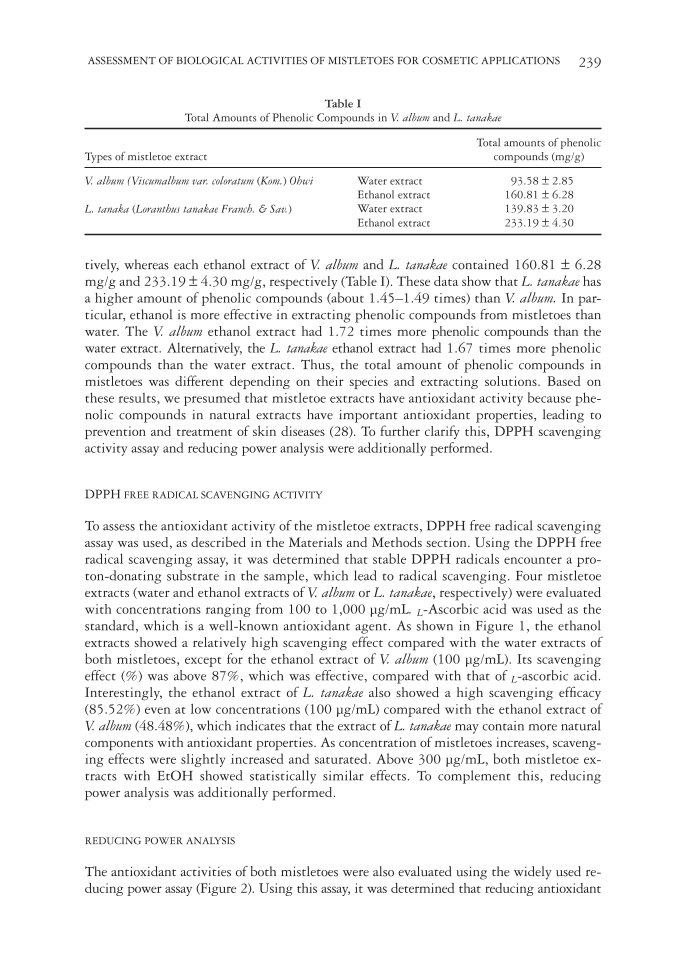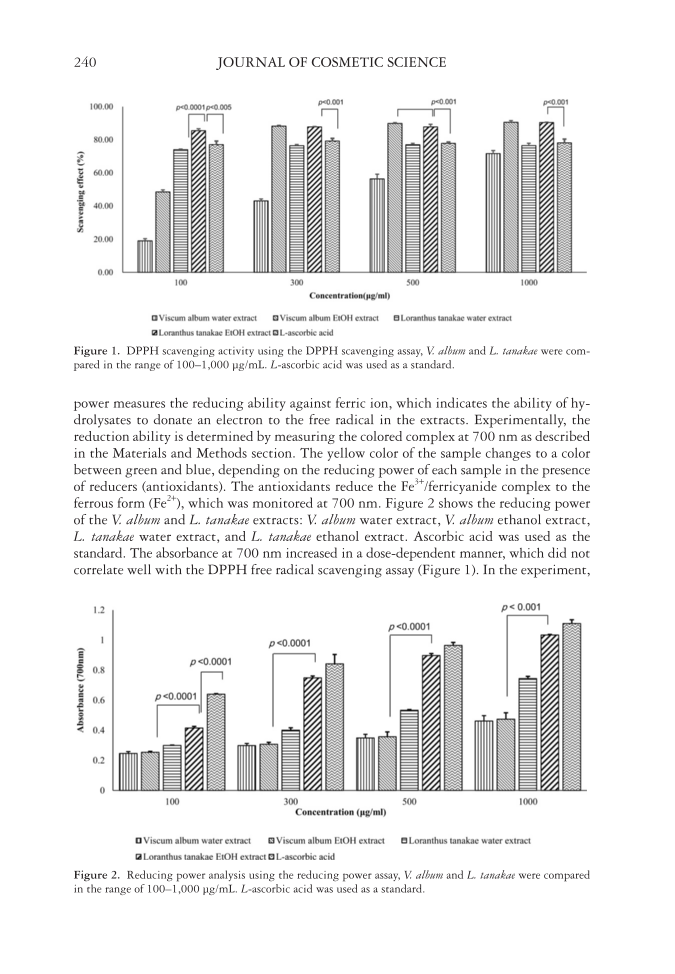ASSESSMENT OF BIOLOGICAL ACTIVITIES OF MISTLETOES FOR COSMETIC APPLICATIONS 239 tively, whereas each ethanol extract of V. album and L. tanakae contained 160.81 ± 6.28 mg/g and 233.19 ± 4.30 mg/g, respectively (Table I). These data show that L. tanakae has a higher amount of phenolic compounds (about 1.45–1.49 times) than V. album. In par- ticular, ethanol is more effective in extracting phenolic compounds from mistletoes than water. The V. album ethanol extract had 1.72 times more phenolic compounds than the water extract. Alternatively, the L. tanakae ethanol extract had 1.67 times more phenolic compounds than the water extract. Thus, the total amount of phenolic compounds in mistletoes was different depending on their species and extracting solutions. Based on these results, we presumed that mistletoe extracts have antioxidant activity because phe- nolic compounds in natural extracts have important antioxidant properties, leading to prevention and treatment of skin diseases (28). To further clarify this, DPPH scavenging activity assay and reducing power analysis were additionally performed. DPPH FREE RADICAL SCAVENGING ACTIVITY To assess the antioxidant activity of the mistletoe extracts, DPPH free radical scavenging assay was used, as described in the Materials and Methods section. Using the DPPH free radical scavenging assay, it was determined that stable DPPH radicals encounter a pro- ton-donating substrate in the sample, which lead to radical scavenging. Four mistletoe extracts (water and ethanol extracts of V. album or L. tanakae, respectively) were evaluated with concentrations ranging from 100 to 1,000 μg/mL. L -Ascorbic acid was used as the standard, which is a well-known antioxidant agent. As shown in Figure 1, the ethanol extracts showed a relatively high scavenging effect compared with the water extracts of both mistletoes, except for the ethanol extract of V. album (100 μg/mL). Its scavenging effect (%) was above 87%, which was effective, compared with that of L -ascorbic acid. Interestingly, the ethanol extract of L. tanakae also showed a high scavenging effi cacy (85.52%) even at low concentrations (100 μg/mL) compared with the ethanol extract of V. album (48.48%), which indicates that the extract of L. tanakae may contain more natural components with antioxidant properties. As concentration of mistletoes increases, scaveng- ing effects were slightly increased and saturated. Above 300 μg/mL, both mistletoe ex- tracts with EtOH showed statistically similar effects. To complement this, reducing power analysis was additionally performed. REDUCING POWER ANALYSIS The antioxidant activ ities of both mistletoes were also evaluated using the widely used re- ducing power assay (Figure 2). Using this assay, it was determined that reducing antioxidant Table I Total Amounts of Phenolic Comp o unds in V. album and L. tanakae Types of mistletoe extract Total amounts of phenolic compounds (mg/g) V. album (Viscumalbum var. coloratum (Kom.) Ohwi Water extract 93.58 ± 2.85 Ethanol extract 160.81 ± 6.28 L. tanaka (Loranthus tanakae Franch. & Sav.) Water extract 139.83 ± 3.20 Ethanol extract 233.19 ± 4.30
JOURNAL OF COSMETIC SCIENCE 240 power measures the reducing ability against ferric ion, which indicates the ability of hy- drolysates to donate an electron to the free radical in the extracts. Experimentally, the reduction ability is determined by measuring the colored complex at 700 nm as described in the Materials and Methods section. The yellow color of the sample changes to a color between green and blue, depending on the reducing power of each sample in the presence of reducers (antioxidants). The antioxidants reduce the Fe3+/ferricyanide complex to the ferrous form (Fe2+), which was monitored at 700 nm. Figure 2 shows the reducing power of the V. album and L. tanakae extracts: V. album water extract, V. album ethanol extract, L. tanakae water extract, and L. tanakae ethanol extract. Ascorbic acid was used as the standard. The absorbance at 700 nm increased in a dose-dependent manner, which did not correlate well with the DPPH free radical scavenging assay (Figure 1). In the experiment, Figure 1. DPPH scavenging a c tivity using the DPPH scavenging assay, V. album and L. tanakae were com- pared in the range of 100–1,000 μg/mL. L-ascorbic acid was used as a standard. Figure 2. Reducing power analy s is using the reducing power assay, V. album and L. tanakae were compared in the range of 100–1,000 μg/mL. L-ascorbic acid was used as a standard.
Purchased for the exclusive use of nofirst nolast (unknown) From: SCC Media Library & Resource Center (library.scconline.org)


















































